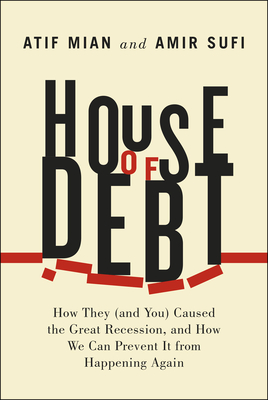House of Debt: How They (and You) Caused the Great Recession, and How We Can Prevent It from Happening Again
Atif Mian

This is a near-perfect book of popular economics, which I have been meaning to read for a long time but only recently got around to. I am very often disappointed when I read popular economics books, generally because I end up wishing they were more academic. But Mian and Sufi manage an extremely difficult combination of writing in a very accessible style, providing both theoretical and empirical support, and even coming up with some decent policy recommendations.
The main thesis of the book is that the Great Recession was so bad primarily because of the debt overhang on households who had borrowed too much against residential real estate. They offer this view in contrast primarily to the view that the recession was bad primarily because of the near-collapse of the banking sector and the fact that “banks stopped lending”. This is an important distinction because the two theories produce very different policy recommendations: bail out the banks, which is what was actually done, or bail out people with underwater mortgages, which was given lip service but barely done at all in practice. Mian and Sufi adduce a wide variety of empirical evidence to support their point, primarily based on disaggregated geographic data comparing regions with high debt burdens to those without. They make reasonably clean comparisons by, for example, looking at employment losses in tradeable vs. non-tradeable sectors, or comparing metro areas with geographic constraints on housing supply and those with no such constraints. They do an excellent job explaining these analyses in plain language, even though the underlying econometrics are somewhat complex.
In brief, their high-level argument is that debt is largely bad for the macroeconomy because it shifts risk precisely to the people who are least able to bear it. (Poor people borrow and rich people lend; the debt contracts expose the borrower to the first loss and give the lender a senior claim.) This setup gives lenders reason to lend even when they believe asset values are inflated (as long as the borrower puts in enough equity). It also concentrates asset price declines on those with the highest marginal propensity to consume out of wealth, which maximizes the deleterious impact on the economy. They argue for more equity-like financing arrangements, and while their “shared responsibility mortgage” seems a little bit complicated, I applaud them for coming up with a real policy proposal based on their analysis.
It is interesting that both views I described at the beginning can be characterized as “hold your nose morality plays”. In the standard view, we hold our nose and bail out the banks even though they were making bad loans, because it’s the right thing to do for the economy. In Mian and Sufi’s view, we hold our nose and bail out indebted homeowners even though they borrowed too much, because it’s the right thing to do for the economy. It’s worth reflecting on which side we’re more willing to hold our noses for.